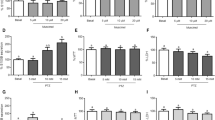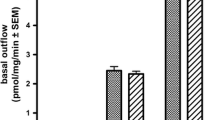Abstract
Several molecules have been shown to be involved in glial-neuronal communication, including S100B, an astrocyte-derived neurotrophic cytokine. Extracellular S100B protects hippocampal neurons from excitotoxic damage, whilst toxic levels of glutamate to neurons have been shown to reduce S100B secretion in astrocytes and brain slices, by an unknown mechanism. Here, we investigate which mechanisms are possibly involved in this effect in primary cultures of hippocampal astrocytes using glutamate agonists and glutamate uptake inhibitors. DCG-IV, an agonist of group II metabotropic glutamate receptors, caused a smaller decrease in S100B secretion when compared to 1 mM glutamate. d-aspartate partially reverted the glutamate effect on S100B release and two other inhibitors, PDC and DIDS, reverted it completely. These findings suggest that S100B secretion is inversely coupled to glutamate uptake. Decrease in S100B secretion may be considered as direct excitotoxic damage, but a beneficial mechanism effect cannot be ruled out, because S100B elevation could cause an additional cell death.






Similar content being viewed by others
References
Haydon PG (2001) Glia: listening and talking to the synapse. Nat Rev Neurosci 2:185–193
Schousboe A (2003) Role of astrocytes in the maintenance and modulation of glutamatergic and GABAergic neurotransmission. Neurochem Res 28:347–352
Araque A, Perea G (2004) Glial modulation of synaptic transmission in culture. Glia 47:241–248
Donato R (2001) S100: a multigenic family of calcium-modulated proteins of the EF-hand type with intracellular and extracellular functional roles. Int J Biochem Cell Biol 33:637–668
Van Eldik LJ, Wainwright MS (2003) The Janus face of glial-derived S100B: beneficial and detrimental functions in the brain. Restor Neurol Neurosci 21:97–108
Danbolt NC (2001) Glutamate uptake. Prog Neurobiol 65:1–105
Chen Y, Swanson RA (2003) Astrocytes and brain injury. J Cer Blood F Metab 23:137–149
Ahlemeyer B, Beier H, Semkova I et al (2000) S-100beta protects cultured neurons against glutamate- and staurosporine-induced damage and is involved in the antiapoptotic action of the 5 HT(1A)-receptor agonist, Bay x 3702. Brain Res 858:121–128
Kögel D, Peters M, Konig HG et al (2004) S100B potently activates p65/c-Rel transcriptional complexes in hippocampal neurons: clinical implications for the role of S100B in excitotoxic brain injury. Neuroscience 127:913–920
Gonçalves D, Karl J, Leite M et al (2002) High glutamate decreases S100B secretion stimulated by serum deprivation in astrocytes. Neuroreport 13:1533–1535
Büyuküysal RL (2005) Protein S100B release from rat brain slices during and after ischemia: comparison with lactate dehydrogenase leakage. Neurochem Int 47:580–588
Pinto SS, Gottfried C, Mendez A et al (2000) Immunocontent and secretion of S100B in astrocyte cultures from different brain regions in relation to morphology. FEBS Lett 486:203–207
Catania MV, Giuffrida R, Seminara G et al (2003) Upregulation of neuronal nitric oxide synthase in in vitro stellate astrocytes and in vivo reactive astrocytes after electrically induced status epilepticus. Neurochem Res 28:607–615
Won CL, Oh YS (2000) cAMP-induced stellation in primary astrocyte cultures with regional heterogeneity. Brain Res 887:250–258
Ciani E, Guidi S, Della Valle G et al (2002) Nitric oxide protects neuroblastoma cells from apoptosis induced by serum deprivation through cAMP-response element-binding protein (CREB) activation. J Biol Chem 277:49896–49902
Yao HH, Ding JH, Zhou F et al (2005) Enhancement of glutamate uptake mediates the neuroprotection exerted by activating group II or III metabotropic glutamate receptors on astrocytes. J Neurochem 92:948–961
Abe K, Saito H (2001) L-glutamate suppresses astrocyte stellation induced by actin breakdown in culture. Biol Pharm Bull 24:347–350
Gottfried C, Tramontina F, Gonçalves D et al (2002) Glutamate uptake in cultured astrocytes depends on age: a study about the effect of guanosine and the sensitivity to oxidative stress induced by H(2)O(2). Mech Ageing Dev 123:1333–1340
Lowry OH, Rosebrough NJ, Farr AL, Randall RJ (1951) Protein measurement with the Folin-Phenol reagents. J Biol Chem 193: 265–275
Tramontina F, Karl J, Gottfried C et al (2000) Digitonin-permeabilization of astrocytes in culture monitored by trypan blue exclusion and loss of S100B by ELISA. Brain Res Protoc 6:86–90
Ciccarelli R, Di Iorio P, Bruno V et al (1999) Activation of A(1) adenosine or mGlu3 metabotropic glutamate receptors enhances the release of nerve growth factor and S-100beta protein from cultured astrocytes. Glia 27:275–281
Kanumilli S, Toms NJ, Roberts PJ (2004) Novel metabotropic glutamate receptor negatively coupled to adenylyl cyclase in cultured rat cerebellar astrocytes. Glia 46:1–7
Labourdette G, Mandel P (1980) Effect of norepinephrine and dibutyryl cyclic AMP on S-100 protein level in C6 glioma cells. Biochem Biophys Res Commun 96:1702–1709
Guillet BA, Velly LJ, Canolle B et al (2005) Differential regulation by protein kinases of activity and cell surface expression of glutamate transporters in neuron-enriched cultures. Neurochem Int 46:337–346
Had-Aissouni L, Re DB, Nieoullon A et al (2002) Importance of astrocytic inactivation of synaptically released glutamate for cell survival in the central nervous system – are astrocytes vulnerable to low intracellular glutamate concentrations? J Physiol 96:317–322
Steiner MR, Urso JR, Klein J, Steiner SM (2002) Multiple astrocyte responses to lysophosphatidic acids. Biochim Biophys Acta 1582:154–160
Tramontina F, Tramontina AC, Souza DF et al (2006) Glutamate uptake is stimulated by extracellular S100B in hippocampal astrocytes. Cell Mol Neurobiol 26:81–86
Holtje M, Hoffmann A, Hofmann F et al (2005) Role of Rho GTPase in astrocyte morphology and migratory response during in vitro wound healing. J Neurochem 95:1237–1248
Acknowledgment
Brazilian funds from Conselho Nacional de Desenvolvimento Científico e Tecnológico (CNPq) and Fundação de Amparo a Pesquisa do Rio Grande do Sul (FAPERGS).
Author information
Authors and Affiliations
Corresponding author
Additional information
The authors Francine Tramontina and Marina C. Leite are equally contributed to this work.
Rights and permissions
About this article
Cite this article
Tramontina, F., Leite, M.C., Gonçalves, D. et al. High Glutamate Decreases S100B Secretion by a Mechanism Dependent on the Glutamate Transporter. Neurochem Res 31, 815–820 (2006). https://doi.org/10.1007/s11064-006-9085-z
Accepted:
Published:
Issue Date:
DOI: https://doi.org/10.1007/s11064-006-9085-z




